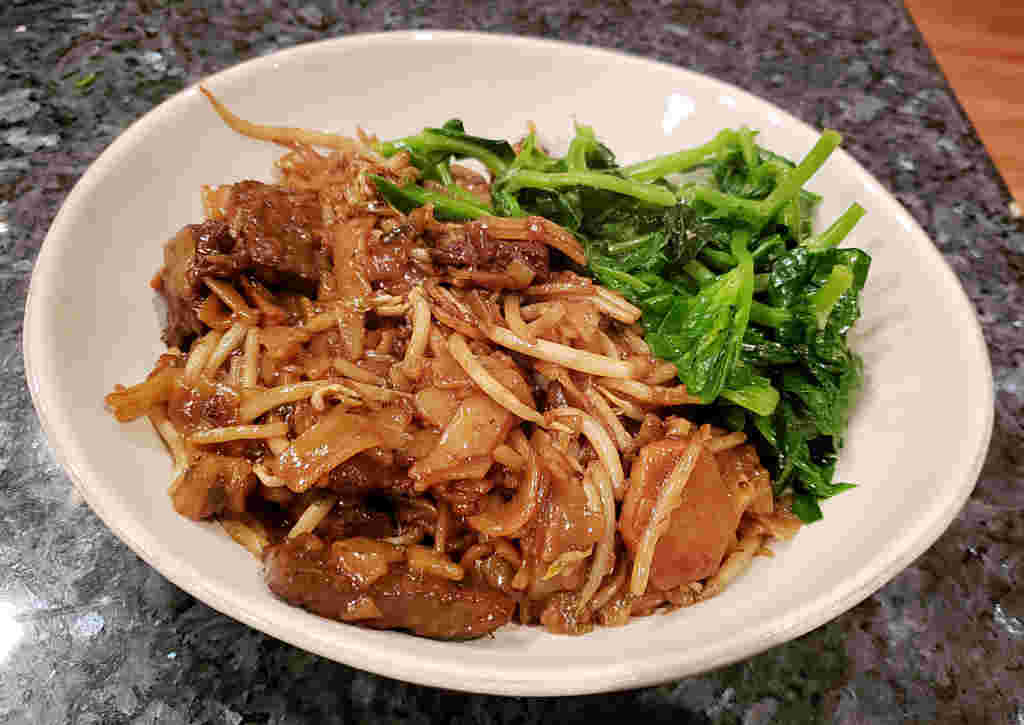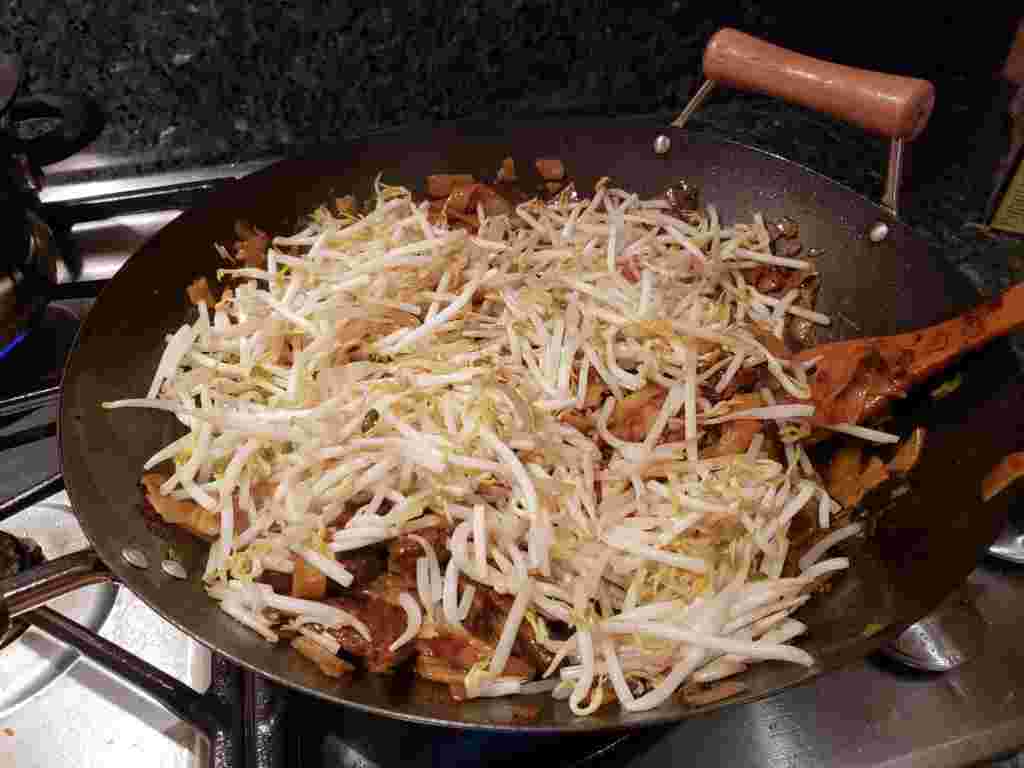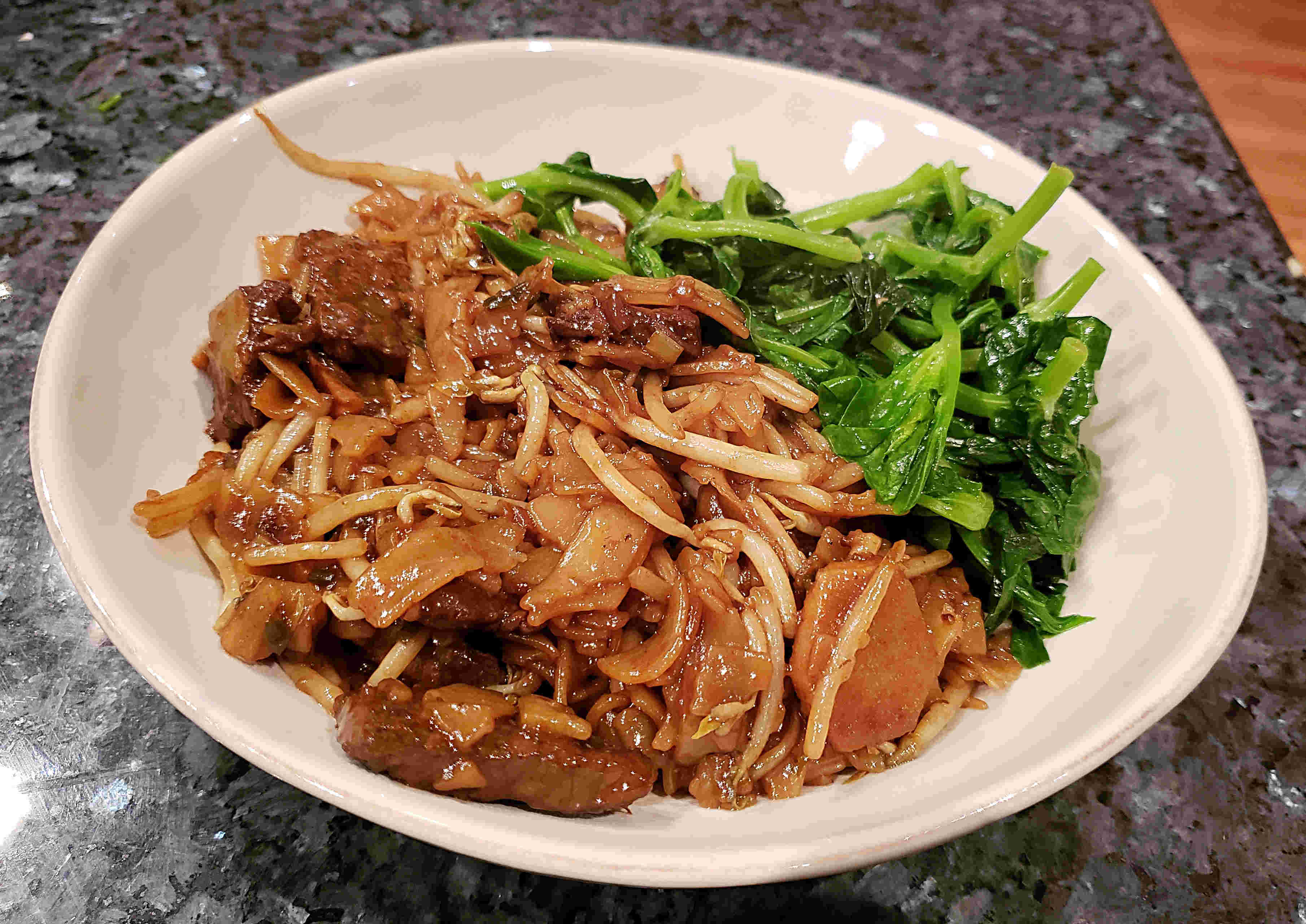
My dad’s family is originally from Northern China, where wheat is the staple crop and reigns supreme. The food there is dominated by wheat-flour products such as noodles, dumplings, and steamed buns stuffed with salty pork and cabbage or sweet red bean paste. My mom’s family is from the south of China, in Guandong, where rice production is much more prevalent. When I was growing up, my family liked to tease me that I could never decide between noodles or rice, wanting and loving them both, due to my diverse family tree. This is as true now as it was then – there will always, always be carbohydrates in my future.
However, possibly my favorite dish in the world – one that I always request at Chinese restaurants – is beef chow fun, a staple Cantonese dish that combines the best of both worlds: rice flour is made into thick, chewy noodles that are pan-fried with dark, salty soy sauce and tossed with aromatic beef, crisp bean sprouts, and bright scallions. I have always loved this dish – it’s so simple, but so flavorful, a Chinese comfort food that’s greater than the sum of its parts and distinct in its flavor. You’ve probably had beef chow fun before – it’s quite popular, and usually on the menu of any restaurant that serves Cantonese food. But it’s also incredibly easy to make if you can source good rice noodles! There are only a handful of other ingredients, it takes about 30 minutes, and the seasoning is straightforward, relying on soy sauce, sesame oil, and, if you have it, Shaoxing wine. It’s so easy, in fact, that this time, as I was busy gabbing away on the phone to my girlfriends, James made this entire dish himself, following the recipe he found on The Woks of Life! That’s right – these pictures all represent his cooking and his alone – what a good little Asian chef!

When buying rice noodles, fresh noodles are best and tastiest, although dried noodles will also work. Fresh rice noodles can be found at most Asian supermarkets, in the refrigerated section with the fresh wheat noodles and probably next to tofu and bean sprouts. They’ll be labeled as rice noodles, but could also be labeled as “he fen,” “hor fun,” “sha ho fon,” or some variant there of. Sometimes it can be sold as whole sheets instead of noodles – this is the same thing, you’ll just have to cut the sheets yourself into approximately 1/2- to 3/4-inch strips. Chow fun is traditionally made with wide rice noodles, but it’s versatile so feel free to substitute whatever you can find (if you substitute wheat noodles, you’re not really making chow fun anymore, but I do believe it will still taste good, and the name hardly matters!). For dried rice noodles, you might find them at any large supermarket (A Taste of Thai is a brand I see in American markets), but they’ll be in Asian supermarkets as well, with the other dried noodles.

Some other notes:
- Like with many other stir-fried Chinese dishes that are traditionally made with a wok, less is more. As in, less ingredients in the pan at once. Often times these dishes are only made 1 or 2 servings at a time, so as to not crowd the wok and impede free movement of food and good sear. However, if you’ve been following me, you’ll know that one of the largest culinary faux-pas I make is to crowd the pan against everyone’s warning, because I am lazy and want to make as much food as I can with the least amount of time and effort possible. This results in a softer, saucier, wetter dish, as opposed to the drier, charred, chewier noodles you find at restaurants. The weight of all the food in the pan also can cause the noodles to break up into smaller pieces, as you see in the pictures. The flavors, however, will still be delicious, and, for a weeknight meal, this is perfectly ok! If, however, you would like a drier, more seared noodle dish, halve the recipe, or cook it in two batches.
- High heat is important! It will appropriately sear the beef and the noodles, and bring out all of the flavors. If you fear that the noodles are burning, you’re doing it right!
- Consistently tossing the noodles once you’ve added them will keep them from sticking to each other and distribute all the flavors and sauce.
- Shaoxing wine will give the dish a more authentic, complex flavor, but we actually didn’t have any when James made it this time, and it was still delicious.
- This dish is very versatile. The ingredient quantities are all quite flexible – if you want the dish to be meatier, add more meat; if you love noodles as I do, add more noodles, etc.!

We served this with some sauteed pea shoots. Total time to dinner, including sides: about 40 minutes. Easy peasy!

| Servings | Fuss Factor | Total Time | Prep Time | Cook Time |
|---|---|---|---|---|
| 4-5 | 1 | 30 minutes | 20 minutes | 10 minutes |

Beef Chow Fun
Adapted (by James!) from The Woks of Life
Ingredients
Marinade:
- 1/2 teaspoon baking soda
- 1 tablespooon corn starch
- 1 tablespoon regular soy sauce
- 1 tablespoon Shaoxing wine (or dry sherry)
- 1 tablespoon canola or other neutral oil
For the chow fun:
- 1 pound beef skirt, flank, sirloin, or tenderloin
- 2 pounds fresh wide rice noodles, or 1 pound dried wide rice noodles
- 4 tablespoons peanut, vegetable, or canola oil
- 5-7 thin slices ginger
- 1 bunch scallions, split in half vertically and sliced into 3-inch pieces
- 1/4 cup Shaoxing wine (or dry sherry or water)
- 1 teaspoon sesame oil
- 2 tablespoons dark soy sauce (can substitute regular soy sauce here, the final color of the dish will just be a lighter brown)
- 1/4 cup regular soy sauce
- 1 teaspoon sugar
- 1 pound fresh bean sprouts
- Salt and white pepper, to taste
Instructions
-
Slice beef against the grain into 1/4-inch strips. Combine the beef strips and all of the marinade ingredients in a small bowl and mix gently, until all of the beef is coated. Let sit for at least 15 minutes while you prepare the rest of the ingredients.
-
If using fresh rice noodles, take them out from the fridge and allow them to come to room temperature. You'll add fresh noodles directly to the pan with the oil, ginger, and scallions without any pre-cooking.
If using dried rice noodles, prepare according to package instructions. Different brands may have slightly different instructions, and some may ask you to soak the noodles, boil them, or both. Cook the rice noodles according to package instructions until cooked through, but still a bit chewy inside - the noodles will cook further as you stir fry them with the beef. Rinse rice noodles with cold water and drain. If you're not ready to use them yet, add about 1 tablespoon of sesame oil to the drained noodles and gently toss to combine noodles with a thin coat of oil. This will prevent the noodles from sticking to each other as you stir fry them.
-
Heat a wok or large skillet over medium-high heat until hot, and add 2 tablespoons oil to coat the pan. Add the beef and cook, stirring occasionally, until browned on the outside and slightly pink on the inside, about 3-5 minutes. Remove the beef from the pan and set aside.
-
Add the remaining 2 tablespoons of oil to the pan over medium-high heat. Add the ginger and scallions and cook until fragrant, about 30 seconds. Add the rice noodles evenly in the pan, and toss immediately with tongs or a large spatula to mix with the oil and aromatics, about 15 seconds. Add the Shaoxing wine, sherry, or water, and toss again to combine.
-
Add the beef mixture to the pan, along with the sesame oil, soy sauces, and sugar. Immediately toss again, flipping and turning the noodles to make sure that noodles are evenly coated with the beef and sauce mixture.
-
Add the bean sprouts and cook, tossing, until sprouts are just tender. Taste, and add more salt and pepper, if desired. Give everything a final toss, and serve!


